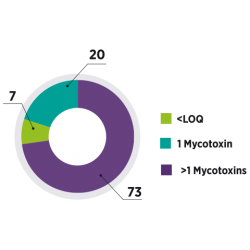Jog Raj*, Hunor Farkaš, Zdenka Jakovčević, Nemanja Todorović, Jasna Bošnjak-Neumüller y Marko Vasiljević
PATENT CO,. Mišićevo, Serbia
Mycotoxins are the biggest challenge for animal feed producers and therefore, regular monitoring of mycotoxins is necessary.
 The aim of the present study was to screen corn samples for mycotoxins, received from different countries and regions of the world, between September 2019 and February 2020.
The aim of the present study was to screen corn samples for mycotoxins, received from different countries and regions of the world, between September 2019 and February 2020.

The corn samples were collected from North and South America (Mexico, Chile, Peru, Colombia, Argentina, Brazil) Asia (India, Iraq, Thailand, Vietnam, Taiwan) and Europe (Serbia, Spain, France, Italy, Bosnia & Herzegovina, Russia, Belarus, and Croatia).
 RESULTS
RESULTS
- ⇰ Mycotoxins detected in the corn samples in each country in 2019 and the overall conclusions based on the integrated global data sets for this year.
- ⇰ Comparisons of the mycotoxins detected in 2018 v 2019.
- ⇰ Effects of detected mycotoxins on animals.
- ⇰ Overall Conclusions.
 MYCOTOXINS DETECTED in corn per country in 2019
MYCOTOXINS DETECTED in corn per country in 2019
 CHILE
CHILE
In 2019, 93% of the corn samples received from Chile were contaminated with one or more mycotoxins (Fig 1).

Fig 1. Number (%) of mycotoxins detected in corn samples from Chile
Higher and co-occurrence of Fumonisins (93% of the samples) followed by DON in 20% and ZON in 7% samples was recorded (Table 1).

Table 1. Mycotoxin contamination levels (ppb) in corn samples from Chile in 2019









 Micotoxicosis prevention
Micotoxicosis prevention